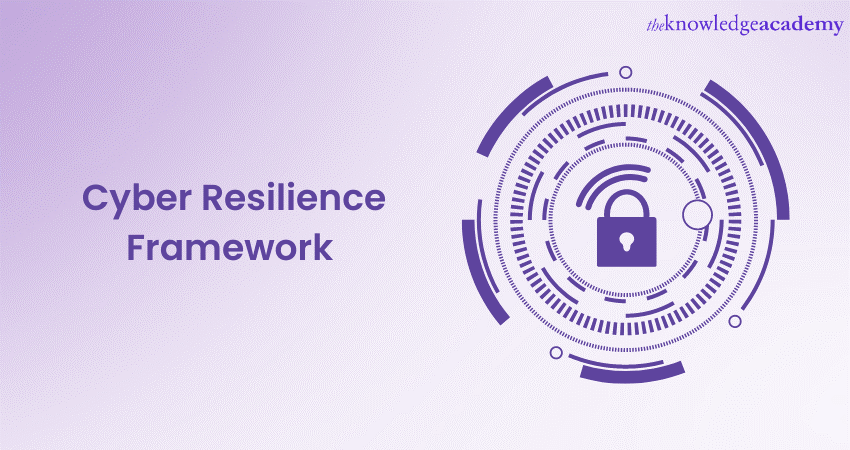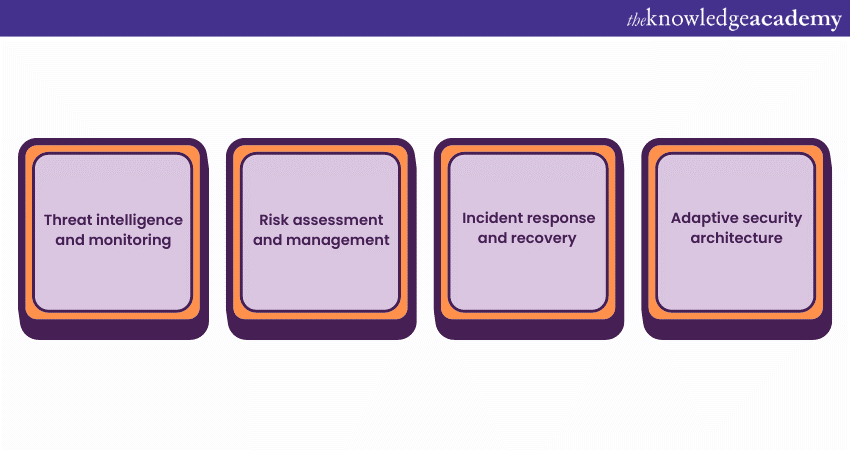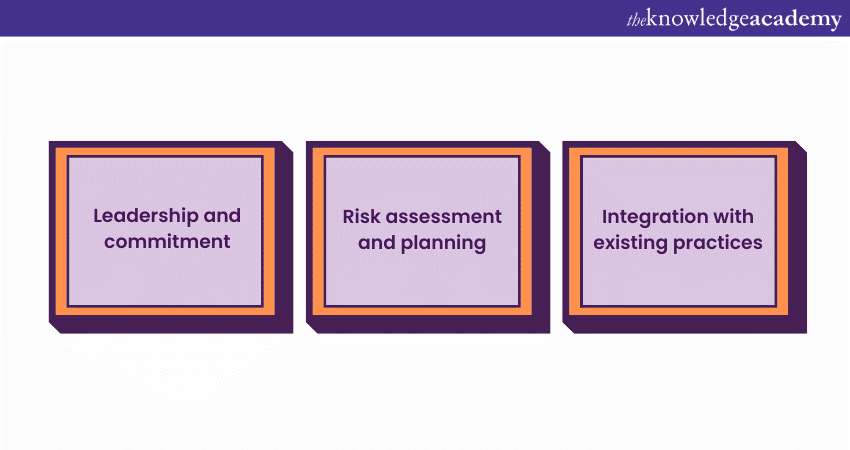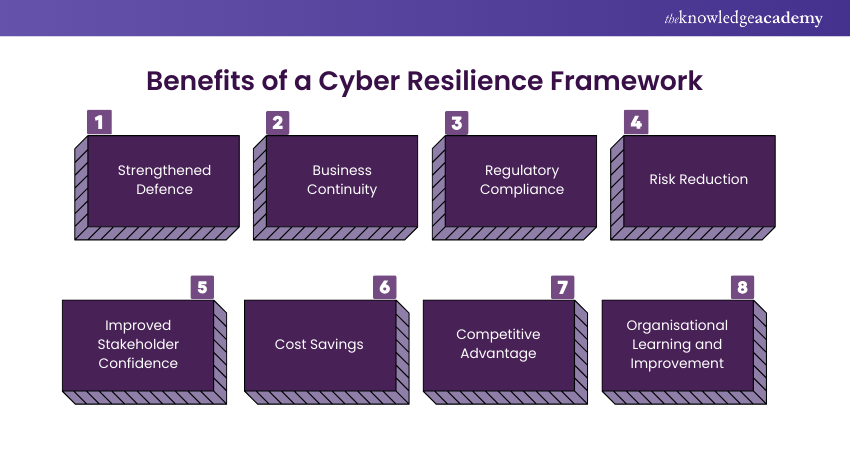We may not have the course you’re looking for. If you enquire or give us a call on +61 272026926 and speak to our training experts, we may still be able to help with your training requirements.
Training Outcomes Within Your Budget!
We ensure quality, budget-alignment, and timely delivery by our expert instructors.

In a connected world where cyber threats loom large, organisations must fortify their defences beyond mere cybersecurity measures. The emergence of the Cyber Resilience Framework stands as a beacon of hope amidst escalating cyberattacks. As the threat evolves, the need for a comprehensive approach that safeguards and ensures the recovery and continuity of operations has become paramount.
Navigate the evolving landscape of cyber threats with our holistic Cyber Resilience framework. Continue reading below to gain insights on strengthening business strategies and fortifying your digital resilience.
Table of Contents
1) The Growing Threat of Cyberattacks
2) Understanding Cyber Resilience
3) What are Cyber Resilience Frameworks?
4) Key Components of a Cyber Resilience Framework
5) Examples of Cyber Resilience Frameworks
6) Implement a Cyber Resilience Framework
7) Benefits of a Cyber Resilience Framework
8) Improving the Cyber Resilience Framework
9) Cyber Resilience Framework and Regulatory Compliance
10) Cyber Resilience Best Practices
11) Conclusion
The Growing Threat of Cyberattacks
The growing threat of cyberattacks casts a long shadow over individuals, businesses, and governments. The internet has undoubtedly brought unparalleled connectivity, innovation, and progress opportunities. However, it has also exposed us to a new extent of vulnerabilities that malicious actors are all too eager to exploit.
Cyberattacks have evolved from isolated and simplistic attempts to disrupt systems into sophisticated, well-coordinated campaigns that can wreak havoc on a global scale. Gone are the days when hackers operated solely for the thrill of causing chaos or gaining notoriety.
Today, cybercriminals have adopted a professional and profit-driven mindset, often working as part of more extensive criminal networks or state-sponsored entities.
Our increasing dependence on technology has expanded the attack surface for cybercriminals. Internet of Things (IoT) devices, often designed conveniently rather than securely, can serve as network entry points. While offering immense benefits, cloud computing also introduces potential vulnerabilities if not properly secured.
Understand Cyber Resilience
Cyber Resilience has emerged as a critical pillar of modern Cyber Security strategies. Unlike traditional approaches that focus primarily on preventing cyberattacks, Cyber Resilience acknowledges the inevitability of breaches and disruptions while emphasising an organisation's ability to withstand, respond to, and recover from such incidents.
It encompasses a comprehensive set of strategies, practices, and technologies that collectively fortify an organisation's ability to endure, adapt, and thrive in the face of ever-evolving cyber threats. It acknowledges that the digital landscape is inherently risky and aims to mitigate the impact of incidents rather than solely preventing them.
While Cyber Security and Cyber Resilience are often used interchangeably, they represent distinct yet complementary concepts. Cyber Security predominantly concentrates on establishing protective measures to prevent unauthorised access, data breaches, and cyberattacks. It encompasses tools like firewalls, encryption, and intrusion detection systems.
On the other hand, Cyber Resilience transcends the boundaries of prevention to encompass the full spectrum of incident response and recovery. It assumes that breaches are unfortunate and focuses on minimising the damage, reducing downtime, and ensuring that the organisation can continue its operations as smoothly as possible.
Unlock the potential of Cyber Resilience with our RESILIA® Certification Course. Elevate your team's capabilities to safeguard against cyber threats and ensure business continuity.
What are Cyber Resilience Frameworks?
Cyber Resilience Frameworks provide structured best practices and recommended security controls that organisations can adopt to enhance their ability to block, withstand, and recover from cyber threats. Rather than listing strict rules or specifying technologies or products, these frameworks offer valuable guidance on improving overall Cyber Resilience.
The primary objective of these frameworks is to help organisations develop a robust and adaptable security posture. They cover a broad range of areas, including risk management, incident response, business continuity, and disaster recovery.
By following the principles outlined in these frameworks, organisations can create a more resilient infrastructure that not only prevents cyberattacks but also ensures rapid recovery and continuity of operations in the event of a breach.
Organisations are encouraged to tailor these frameworks to fit their unique needs and objectives. This customisation ensures that the Cyber Resilience measures implemented are relevant and effective in addressing specific challenges and risks. By integrating these best practices into their security strategy, organisations can better protect their assets, maintain customer trust, and ensure long-term operational stability.
Key Components of a Cyber Resilience Framework
The Cyber Resilience Framework, designed to weather the storm of cyber incidents, comprises a strategic amalgamation of critical components that fortify an organisation's ability to respond to and recover from cyberattacks. Let's explore these pivotal components in detail:

Threat intelligence and monitoring
Proactive identification of potential threats is at the core of Cyber Resilience. It constantly monitors network activities and digital environments to detect anomalies, vulnerabilities, and signs of compromise. Threat intelligence leverages data from various sources to predict and counter emerging threats, enabling organisations to take pre-emptive actions.
Risk assessment and management
Understanding an organisation's digital vulnerabilities and potential risks is paramount for effective Cyber Resilience. Comprehensive risk assessments evaluate the organisation's assets, openness, and the potential impact of cyber incidents. This information aids in prioritising resources and efforts toward safeguarding critical assets.
Incident response and recovery
An integral aspect of Cyber Resilience is the development of comprehensive incident response and recovery plans.
1) Developing a response plan: A well-defined response plan outlines roles, responsibilities, communication protocols, and containment strategies that minimise the damage of a cyber incident.
2) Business continuity measures: It ensure critical functions can continue even during an incident, minimising disruption to operations and customer service.
Adaptive security architecture
To enhance Cyber Resilience, organisations must architect their digital infrastructure with adaptability. Adaptive security architecture focuses on creating multiple layers of defence that can adjust to emerging threats and attacks.
Examples of Cyber Resilience Frameworks
1) NIST Cyber Security Framework
Developed by the National Institute of Standards and Technology (NIST), this framework offers a flexible, risk-based approach to managing and mitigating cyber risks. It emphasises five core functions: Identify, Protect, Detect, Respond, and Recover.
ISO 27001
Part of the ISO 27000 series, ISO 27001 focuses on establishing an organisation’s Information Security Management System (ISMS). It provides a systematic approach to managing information security risks, including cyber threats.
Cyber Resilience Review (CRR)
Created by the Department of Homeland Security (DHS), the CRR is a no-cost, voluntary assessment that evaluates an organisation’s operational resilience and Cyber Security practices. It helps organisations identify and prioritise areas needing improvement.
Master Cyber Resilience with our RESILIA Practitioner Training – Sign up today!
Implement a Cyber Resilience Framework
Organisations increasingly recognise the need to shift from a reactive cybersecurity stance to a proactive and resilient approach. Implementing a robust Cyber Resilience Framework is the cornerstone of this strategic shift, empowering organisations to not only withstand cyberattacks but also respond swiftly and recover effectively.

Implementing a Cyber Resilience Framework necessitates commitment and support from the highest levels of organisational leadership. Leaders must champion the cause, allocate necessary resources, and emphasise the importance of Cyber Resilience across all levels of the organisation.
Understanding an organisation's digital assets, vulnerabilities, and potential threats is foundational to effective Cyber Resilience. Conducting a thorough risk assessment allows organisations to identify areas of weakness and devise a strategic plan.
A successful Cyber Resilience Framework seamlessly integrates with existing Cyber Security measures, compliance requirements, and overall business operations. It's not a standalone initiative but an enhancement to the organisation's overall security strategy.
Benefits of a Cyber Resilience Framework
Implementing a Cyber Resilience Framework offers numerous benefits to organisations across various industries, including:

a) Strengthened Defence: A Cyber Resilience Framework enhances your organisation’s ability to identify and respond to cyber threats, reducing the likelihood of successful attacks.
b) Business Continuity: Incorporating business continuity planning, a Cyber Resilience Framework ensures minimal disruption to operations during and after a cyberattack, safeguarding your organisation’s reputation and customer trust.
c) Regulatory Compliance: Many industries, including finance, pharmaceuticals, and manufacturing, are subject to strict regulatory requirements. A Cyber Resilience Framework helps you meet these obligations and demonstrate your commitment to cybersecurity.
d) Risk Reduction: A Cyber Resilience Framework enables organisations to proactively address potential risks by identifying and prioritising vulnerabilities and threats. This proactive approach allows for the implementation of preventive measures to mitigate the likelihood of successful attacks.
e) Improved Stakeholder Confidence: Demonstrating a robust Cyber Resilience Framework instils confidence in stakeholders, including customers, partners, and investors. It showcases your organisation’s commitment to protecting sensitive information, fostering trust and credibility in the marketplace.
f) Cost Savings: Investing in Cyber Resilience can lead to significant cost savings in the long run. Organisations can avoid financial losses associated with disrupted operations, data breaches, and regulatory penalties by minimising the impact of cyber incidents and reducing downtime.
g) Competitive Advantage: A well-established Cyber Resilience Framework provides a competitive edge in the marketplace. It demonstrates your organisation’s commitment to cybersecurity, giving you an advantage over competitors and positioning you as a trusted and reliable partner.
h) Organisational Learning and Improvement: Implementing a Cyber Resilience Framework involves continuously monitoring, evaluating, and improving Cyber Security measures. This process facilitates organisational learning, enabling you to adapt and strengthen defences based on evolving threats and industry best practices.
Improving the Cyber Resilience Framework
Cyber Resilience Frameworks provide managers with a reliable, standardised, and systematic approach to mitigating cyber risks, regardless of the complexity of the environment. These frameworks need continual improvement, and the following five activities are essential for enhancing a Cyber Resilience Framework.
1) Identification of a Top Management Coordinator
Assigning a senior manager responsible for Cyber Resilience ensures that there is a champion for Cyber Resilience at the C-suite level. This senior manager will educate board members and secure their support for investment in incident response automation tools and the development of a comprehensive Cyber Resilience Framework.
2) Nurturing a Culture of Cyber Resilience
Leaving Cyber Resilience solely to the security team is a common mistake. If only a few people understand the systems and how to protect them, the security posture weakens as the company grows. All employees should adopt a Cyber Resilience mindset, knowing how to identify and detect malware and phishing threats and understanding the consequences of data breaches.
Leaders must promote teamwork, open communication, and knowledge sharing across teams. Through peer learning and ongoing education, an enterprise can instil a security-focused culture that serves as a solid foundation for the Cyber Resilience Framework.
3) Creating Formal Cyber Security Policies
A strong risk management policy is a vital component of a Cyber Resilience Framework. Documenting proven security processes as official guidelines provides employees with a reliable set of protocols to follow, strengthening the organisation’s security posture.
4) Making Cyber Resilience a Priority at Board Meetings
Incident response strategies and Cyber Resilience Frameworks are dynamic, evolving assets. They require regular review and updates. Security issues should not be confined to a single department.
Enterprise leaders must regularly consult with key stakeholders on security policies, ensuring the organisation maintains a high level of Cyber Resilience and is prepared to respond to and manage threats.
5) Offering Career Paths for Security Professionals
Top security professionals seek continuous learning and career growth opportunities. Without clear pathways for advancement, they may leave for other opportunities. By investing in ongoing training and career development, organisations can cultivate a loyal, highly skilled workforce of security professionals, ensuring long-term engagement and expertise within the company.
Cyber Resilience Frameworks and Regulatory Compliance
Cyber resilience Frameworks are essential for achieving regulatory compliance across various industries. These frameworks provide structured guidelines and best practices to enhance an organisation's ability to prevent, withstand, and recover from cyber threats.
Regulatory bodies, especially in sectors like finance, healthcare, and manufacturing, impose stringent Cyber Security requirements to protect sensitive data and ensure the integrity of operations
Implementing a Cyber Resilience Framework helps organisations meet these regulatory obligations by ensuring robust risk management, incident response, and data protection measures. By adhering to these frameworks, businesses can demonstrate their commitment to maintaining high Cyber Security standards, thereby avoiding legal penalties and safeguarding their reputation.
Additionally, a well-implemented framework facilitates continuous monitoring and improvement, aligning with the dynamic nature of regulatory landscapes. Ultimately, Cyber Resilience Frameworks not only bolster an organisation's security posture but also ensure compliance with industry regulations, fostering trust and confidence among stakeholders.
Cyber Resilience Best Practices
Achieving Cyber Resilience requires balancing people, processes, and technology. Organisations often mistakenly rely too heavily on technology, neglecting the importance of skilled people and well-designed processes. Ensuring Cyber Resilience involves integrating all three components effectively.
a) People: Often the weakest link in cybersecurity, all employees must understand their roles and responsibilities. Organisations should provide role-specific Cyber Security training, ensure top management supports and reviews Cyber Resilience initiatives, educate board members on relevant Cyber Security terms, and establish specialist groups to monitor risks.
b) Processes: Strong governance and processes are crucial. Best practices include maintaining regulatory compliance, validating data controls, agile policy adjustments, using scenario-based strategies for preparedness, and devising effective communication plans. Comprehensive documentation, centralised asset management, continuous monitoring, and deploying various controls are essential measures.
c) Technology: As a key enabler, organisations should invest in response and recovery capabilities, update technologies based on industry standards, adopt automation, create air-gapped copies of critical assets, and leverage advanced technologies like deception to enhance Cyber Resilience.
Conclusion
As the digital domain grows more complex and perilous, the imperative of fortifying an organisation's cyber defences has never been more pronounced. The Cyber Resilience Framework encapsulates a proactive approach that extends beyond protection, embracing swift response and effective recovery. By promoting a culture of preparedness and adaptability, organisations can confidently navigate the storm of cyber incidents.
In adopting the Cyber Resilience Framework, organisations don a resilient armour that empowers them to not only withstand the onslaught of cyber threats but also emerge stronger, ready to thrive in an era where resilience is the cornerstone of survival.
Experience improved response and recovery rates with our RESILIA® Training!
Frequently Asked Questions

A Cyber Resilience Framework focuses on the ability to withstand and recover from cyber threats, not just preventing them. It integrates proactive risk management, incident response, and business continuity, unlike traditional Cyber Security measures which primarily focus on threat prevention.

The effectiveness of a Cyber Resilience Framework is measured by assessing incident response times, recovery speed, business continuity during attacks, regulatory compliance, and the overall reduction in the impact and frequency of cyber incidents.

The Knowledge Academy takes global learning to new heights, offering over 30,000 online courses across 490+ locations in 220 countries. This expansive reach ensures accessibility and convenience for learners worldwide.
Alongside our diverse Online Course Catalogue, encompassing 17 major categories, we go the extra mile by providing a plethora of free educational Online Resources like News updates, Blogs, videos, webinars, and interview questions. Tailoring learning experiences further, professionals can maximise value with customisable Course Bundles of TKA.

The Knowledge Academy’s Knowledge Pass, a prepaid voucher, adds another layer of flexibility, allowing course bookings over a 12-month period. Join us on a journey where education knows no bounds.

The Knowledge Academy offers various RESILIA® Training, including the RESILIA® Foundation and Practitioner Course and RESILIA® Foundation Course. These courses cater to different skill levels, providing comprehensive insights into Cyber Resilience.
Our IT Security & Data Protection Blogs cover a range of topics related to Cyber Resilience, offering valuable resources, best practices, and industry insights. Whether you are a beginner or looking to advance your Cyber Security skills, The Knowledge Academy's diverse courses and informative blogs have got you covered.
Upcoming Batches & Dates
Date








 Top Rated Course
Top Rated Course



 If you wish to make any changes to your course, please
If you wish to make any changes to your course, please


